Cheap DSLR cameras are a great way to get into photography. They offer the same features as more expensive models, but at a fraction of the cost, with less impressive image/video output, but still amazing considering less than 10 years ago cameras were in the infancy. This article will discuss what DSLR cameras are all about and how they compare with other types of camera equipment. It will also give an idea on which one would be best for you based on your needs and budget.
Best Cheap DSLR Cameras

1. Nikon D5600 Digital Camera
The Nikon D5600 is has a DX-format 24.2MP CMOS image sensor to capture vivid details. It is powered by an EXPEED 4 processor that performs well in many settings. This camera can be used to in low light settings thanks to the ISO range of 100 to 25600.
Videos can be recorded at 1080p at 60FPS, making this product suitable for beginners who want to start off with high-resolution content. The camera has 16 scene modes which cater to a backdrops at any time of the day. The audio equipment is also reputable with a stereo microphone integrated.
A variety of features are available but the most noticeable are fast shooting rates at 5 frames per second, as well as the optical view finder. The Nikon D5600 also has a 39-point autofocus that is targeted at capturing people or objects in motion.
The touchscreen 3.2-inch LCD can rotate 180° and comes with a user-friendly interface. The screen enables easy adjustments of photos whether that be cropping or adding in special effects. This is a great travel camera due to the carbon-fibre composite build.
The battery life is long as well, listed at 970 shots. There is Bluetooth, NPC and Wi-Fi compatibility as well.
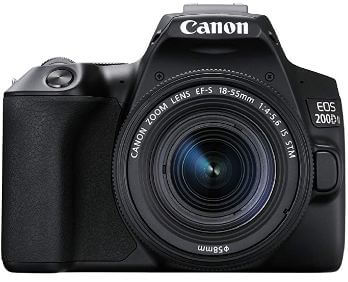
2. Canon EOS 200D Mark II
This is a camera catered towards beginners who are unfamiliar with DSLR cameras. While the Canon EOS 200D Mark II is capable of capturing footage in 1080p at 30p and 60p, there is also the option to take videos in 4K at 25p.
It has an APS-C CMOS image sensor delivering images at approximately 24.1MP. There is a DIGIC 8 processor integrated into the camera in addition to an ISO range from 100-25600. The ISO range can be increased to 51200 to accommodate low-light backgrounds.
Basic photo settings are available such as portrait and landscape but there is also smooth skin available for snapping selfies.
There is a 9-point autofocus system for capturing live footage and a maximum shooting speed of 5 frames per second. There is Live View shooting available with Eye Detection Autofocus.
This product has a 3-inch LCD screen which is easy for beginners to navigate through. The screen can also be adjusted multiple ways to cater to every snapping position available.
This camera can connect to both Wi-Fi and Bluetooth but is not compatible with NPC. There is a battery life of 1070 photos per charge.
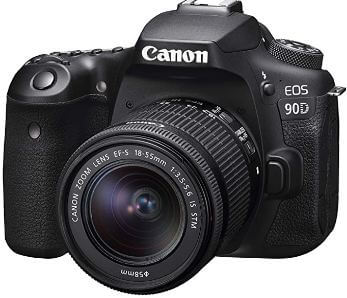
3. Canon 90DKIS
The Canon 90DKIS is a high-powered DSLR camera equipped with a 32.5MP CMOS sensor. This sensor enables crystal clear photos to be taken with small details visible. A DIGIC 8 image processor is embedded to deliver both speed and quality.
There is a shooting speed capped at 11 frames per second, ideal for capturing subjects in motion at every stage. Users can also video record in 4K at 30p. Additionally, videos can also be recorded in 1080p at 120p.
There is a 45-point autofocus system that can be separately controlled or placed all together. This can be done through the optical view finder.
The optical viewfinder also ensures that there are no delays between images seen through the viewfinder and lens. The ISO range is wide at 100-25600 which can be extended to 51200.
This camera is equipped with a 3-inch touchscreen LCD which has a user-friendly interface to locate settings. To give a wide range of control, this product also has a joystick.
Photos can be converted into the JPEG format through the camera and various colour filters can be applied without connection to a laptop. This camera can be connected through Bluetooth and Wi-Fi and has a battery life of 1,860 shots.
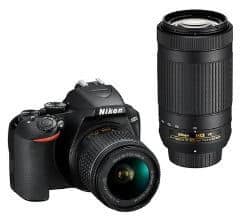
4. Nikon D3500 DSLR
The Nikon D3500 has a 24.2MP CMOS sensor that delivers sharp and distinct images as well as an EXPEED 4 image processor. There is a maximum shooting speed of 5 frames per second and an 11-point autofocus system to pin-point on desired details.
Video recordings can be taken in 1080p at 60p, making it an ideal product to shoot daily vlogs. Photos can be taken at night with minimal blur due to the 100-25600 ISO range. This camera can be connected via Bluetooth to enable control with a smartphone.
SnapBridge is an app available on both iOS and Android, which makes it easy to immediately post photos on social media. Additionally, SnapBridge also has various filter options that eliminate the need for editing on a computer. Snapshots can also be taken through the app.
This is a beginner-friendly product that is designed to be as minimalistic as possible. The 3-inch LCD is not touch activated. There are only a couple of buttons and a Guide Mode for entry-level photographers.
Vibration Reduction technology minimizes the possibility of blurs due to hand shudders. There is a long battery life available at 1550 per charge.
Related: Best 360 Degree Cameras
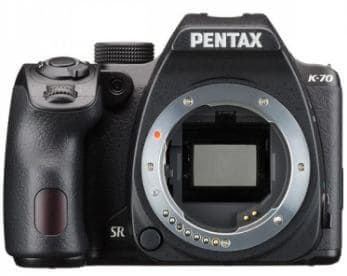
5. Pentax K70
The Pentax K70 is designed for extensive outdoor use due to the durable exterior which is weather-resistant. This camera has a 24.2MP APS-C CMOS sensor and PRIME MII image processor.
The processor, alongside the ISO range of 100-204800 helps capture clear images, especially in dim lighting. There is also an anti-aliasing filter to combat interference patterns and colours. Up to 6 frames per second are available and video footage can be recorded in 1080p at 30fps.
Videos can also be recorded at 720p at 50fps. There are 11 autofocus points, 9 of which are cross types to pinpoint every detail.
This camera has a 3-inch LCD monitor which has night-vison enabled. The monitor can be rotated at various angles and is controlled through the buttons available. This is a product geared towards beginners and professionals alike.
It can be to shoot family photos or scenic views. Wi-Fi connection can be enabled to send photos to smartphones. The Image Sync app is available to download to control shutter speeds and triggers.
The battery life on the Pentax K70 vary depending on the environment as it is targeted towards outdoor use. However, around 410 images can be taken before charging is required.
Related: Best Underwater Cameras
What is a DSLR Camera?
DSLR stands for digital single-lens reflex, sometimes referred to as Digital SLR (Wikipedia). These DSLR cameras are the most popular camera currently in use by professional photographers and amateurs alike, because of their lightweight body, excellent low light performance and interchangeable lenses.
They can be used to take both videos and photos making them great all around picture taking devices, at budget friendly prices (starting at).
How Do DSLR Cameras Work?
The image you see through your DSLR camera’s viewfinder is not the same as that which finally appears on your photo or video files since it has been modified using a mirror system within the DSLR itself.
The “mirror” allows light coming from either side of the lens to hit two different sensors: one located behind the glass and the other in front of it. The DSLR camera’s mirror reflects your subject and changes its orientation so that you can see what is on either side of the lens while framing, without actually capturing this reflected image during exposure.
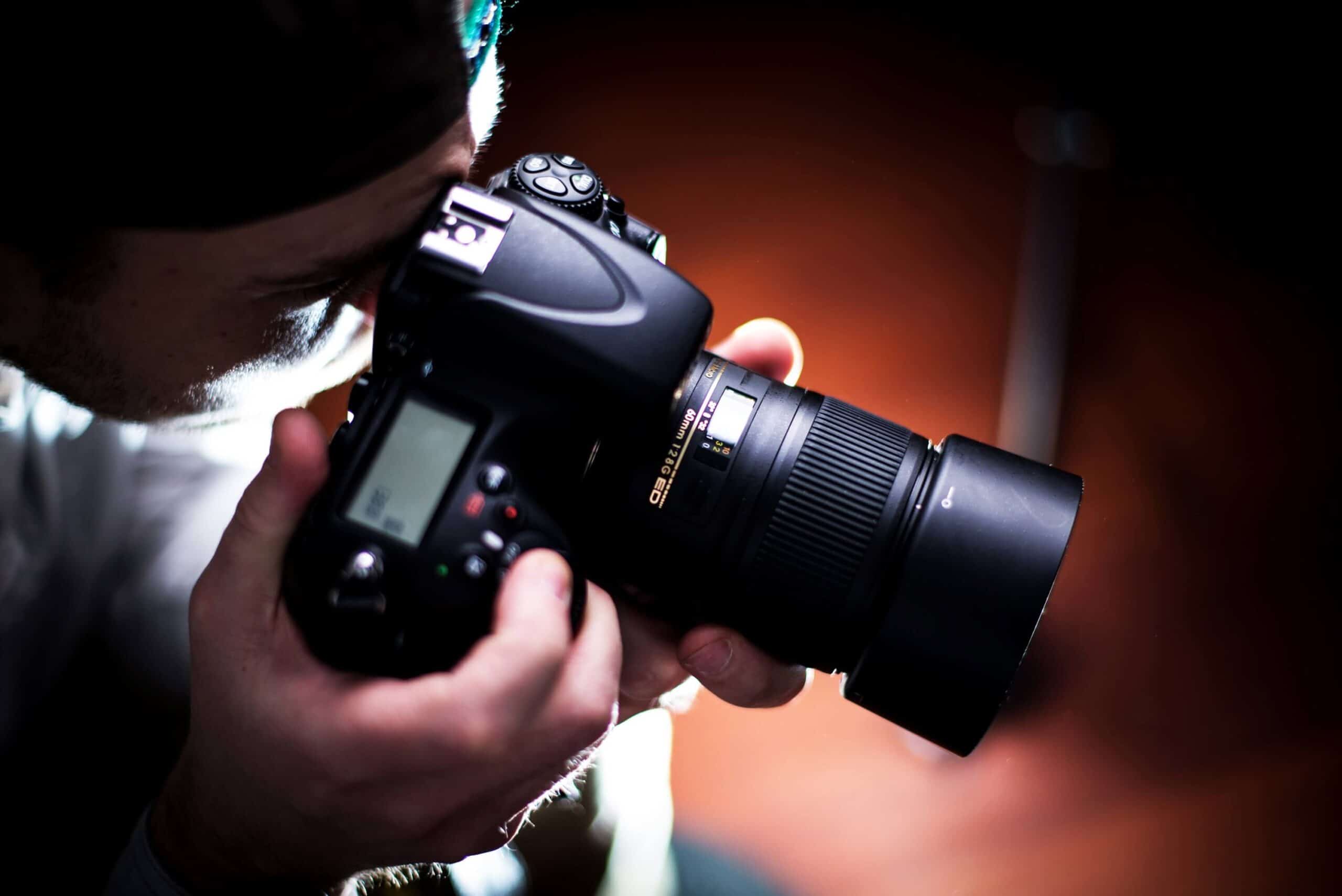
How Can DSLR Camera Be Used?
DSLR cameras can be used to take photos or videos, making them great all around picture taking devices. They come with a variety of features such as different ports including HDMI and USB connections for uploading images to social media networks like Twitter and Facebook; various modes which let you capture shots at certain angles; interchangeable lenses etc..
These cameras also offer excellent low light performance (which lets you shoot objects even when isn’t enough light around) and high pixel resolution (which means you can shoot in RAW mode with DSLR cameras for better editing).
What are the Key Features of DSLR Cameras?
Some key features to look out for when choosing a dslr camera include an adjustable LCD screen, image stabilization, manual or automatic focus options, optical zoom capability etc.. Popular brands like Nikon and Canon offer dslr cameras which come with different pixels resolutions.
Some popular models include Nikon D3300 24MP Digital SLR Camera; Canon EOS Rebel T-S 18 MP CMOS Digital SLR Camera. The prices vary based on brand name but start at $500 dollars upwards.
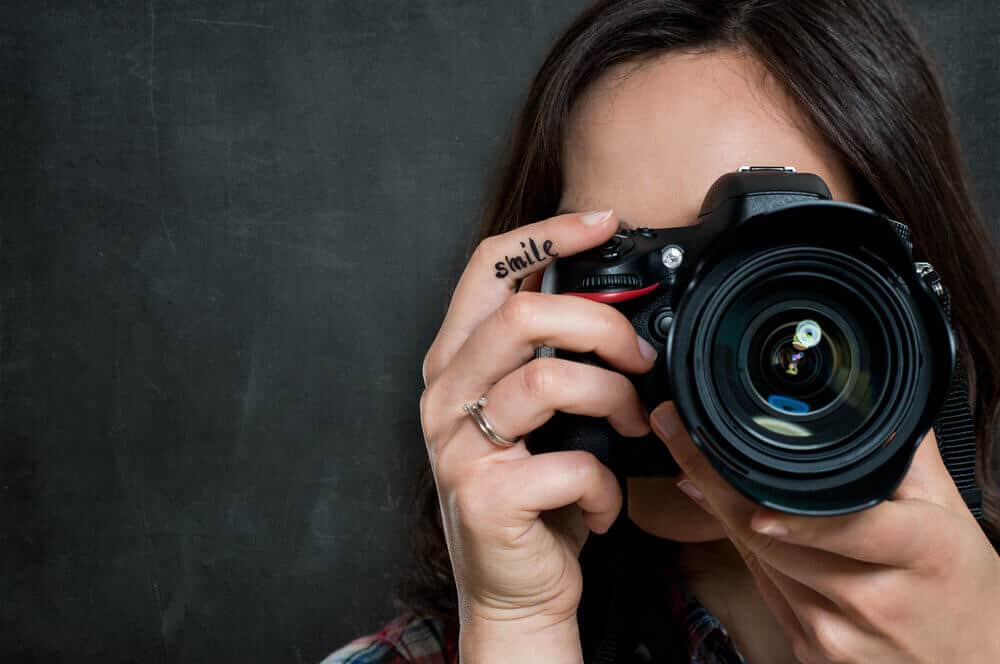
How Much Do Cheap DSLRs Cost?
The DSLR cameras which we have showcased in this article offer great value for money. You can expect to pay anywhere from $500 to $1,000 for a high quality entry level DSLR camera. When buying one, there is often a few contributing factors such as:
- The shell or the base camera, this usually doesn't include any lenses
- The lenses that connect to the camera, can vary in size/zoom quality and pricing. Some long distance lenses can cost $10,000+, while smaller amateur lenses can cost as little as $100 - $300.
- The accessories such as camera bags, straps, lens covers, lens cleaners etc.
When buying a cheap DSLR camera, it's important to consider buying a package which includes the base camera, a couple lenses and often accessories such as a bag, memory card, strap, tripod etc, as this can save you a lot of money!
What is the difference between DSLR and Digital Cameras?
A DSLR camera is a type of digital camera that has an interchangeable lens and uses mirrorless technology.
Digital cameras are usually compact, lightweight devices with little to no moving parts inside the body. The DSLR camera tends to be bigger in size - but not always!
They have external lenses which means they can take better photos than some cheap point-and-shoot digital cameras on the market today.
A DSLR shot will generally yield more professional looking results when compared to a regular digital camcorder because it often provides photographers with many different controls over exposure settings such as aperture priority mode or shutter priority modes etcetera...
Digital cameras use either AA batteries or rechargeable ones whereas DSLR tend to use lithium ion batteries. It's worth noting that these cameras do usually come with rechargeable batteries.
Digital camera is a type of digital imaging device, which uses CCD or CMOS sensors to capture images and videos directly onto electronic media rather than film stock used in traditional photographic methods.
Most point-and-shoot camera manufacturers now focus much more on DSLRs, as they are smaller devices but can take professional looking photos due to their interchangeable lenses etcetera... DSLR cameras have bigger image sensors compared to the small ones found inside most compact digicams - this means better low light performance plus higher dynamic range because larger pixels are generally able to collect more photons per pixel during an exposure . Generally speaking they also give you many different controls over exposure settings such as aperture priority mode or shutter priority modes etc.
There is a big difference between DSLR and digital cameras is that they provide better quality photos because of its interchangeable lenses & bigger sensors which means more control over your shooting environment.
Furthermore DSLRs contain larger image sensors compared to the smaller ones found inside most compact digicams - this means higher dynamic range plus better low light performance. DSLRs also give you various controls like aperture priority mode and ISO speeds for example whereas point-and-shoot camera manufacturers now focus much more on these types of camera due their small sizes yet professional looking results.
How to learn to use a cheap DSLR camera?
Photography is a hobby enjoyed by people all over the world but just because anyone can pick up a DSLR camera this does not mean they know how or even when to use it! Let’s go into detail about some tips on how to learn DSLR photography.
If possible attend free seminars in your local community college or adult education school so that you can learn DSLR basics from a professional.
You should also join meetup groups or organizations in your local area to network with other DSLR photographers and make friends!
Another great way is to take DSLR photography online courses, there are many available for free on the internet that will teach you step-by-step how these cameras work as well as different techniques. Sites such as Udemy.com offer classes for as little as $10.
The key here is this: do not be afraid of asking questions!!! People who know more than you are probably willing to help so don't hesitate ever!
The development of DSLRs has led modern society into an era where almost anyone can become a photographer without knowing exactly what they’re doing at first which means it's important to have some basics under your belt before you go out and take photos.
Who should buy a cheap DSLR camera?
DSLR cameras are not for everyone. If you're just dabbling in photography, stick to the point-and-shoot until your skills improve (or another entry level dslr comes out).
Today's cheap DSLRs offer many more features than their predecessors and can be quite complicated to master. While it used to take years of experience with an older model before upgrading was worthwhile, today’s models provide enough improvements that even amateur photographers will notice a difference between old and new gear.
It really all depends on how much you're going to use your camera, and whether you want the hassle of having to change lenses, the lack of zoom functionality without buying bigger lenses or whether you can forgo those headaches for much clearer photographs.
Related: Best Action Cameras
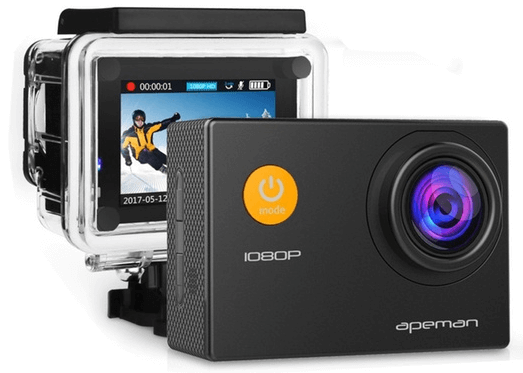
- 5+ Best Home Mesh WiFi Systems For Better Wireless - May 21, 2022
- 6+ Best Heat Resistant Gloves For The Ultimate Grill - May 21, 2022
- 5+ Best Power Towers For The Ultimate Workout - November 30, 2021
Last Updated: December 3, 2021 by Rhys
